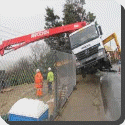 Cranes do not topple over because their jibs or booms are counter balanced at the opposite end from the the lifted load, thus keeping the center of gravity over the base. The first cranes were simply long poles fixed in the ground at an angle, with a pulley at the top through which passed a rope. They were called “cranes” because they looked rather like the neck of the bird with the same name.
Cranes do not topple over because their jibs or booms are counter balanced at the opposite end from the the lifted load, thus keeping the center of gravity over the base. The first cranes were simply long poles fixed in the ground at an angle, with a pulley at the top through which passed a rope. They were called “cranes” because they looked rather like the neck of the bird with the same name.
The derrick crane, which looks like a gallows, is named after Dick Derrick, a 17th Century hangman. In the middle of the 18th Century, steam engines began to be used on cranes, while today the lifting may be done by varieties of power. Jib cranes may be portable, being mounted on a wheeled carriage, or they may be self propelled. Gantry cranes with long booms are used for unloading ships while overhead cranes are used in factories. Goliath cranes, with steel towers at either side, capable of lifting 200 tones are used at some atomic power stations.
 Kids Portal For Parents India Kids Network
Kids Portal For Parents India Kids Network






